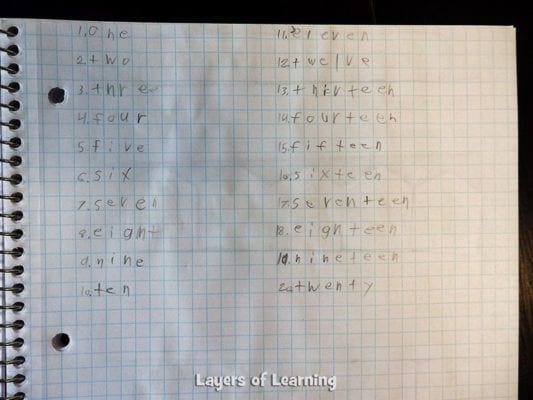Part of math, numbers, and math literacy is learning to spell and write number words. Kids need to be able to write the words after being given a number written in digits and they need to be able to translate the written version into digits.
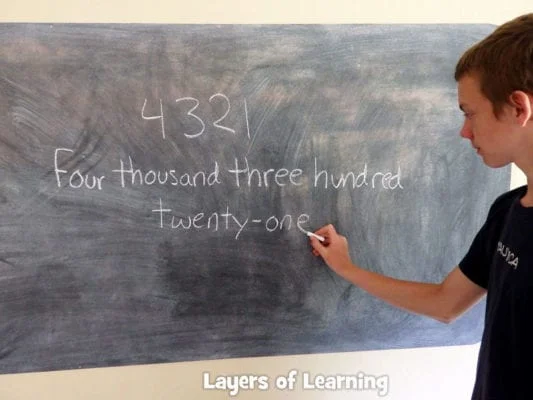
My kids are a bit older, but still struggling with a few of the words and word forms. You can read about how we are learning math from the beginning. They know the number words, mostly, but it is not fluid and automatic. They have to think still when they hit the thousands comma and the decimal and they forget the dash between the thirty and the four when writing thirty-four. And they still misspell some of the words. So my plan is to drill it until it becomes automatic. I wish I had done it from the beginning when they were learning all this for the first time. One of my biggest mistakes in teaching my children has been going soft on the foundations of math. Number sense is incredibly important for later success with algebra.
These two things must happen in every aspect of math learning.
- Understanding of the concepts. They must have an ah-ah! moment where they “get” what is being taught.
- Fluency. They must practice and drill until math skills become automatic. Just like kids learn to read well enough that they no longer think about the letter sounds, they must become so familiar with math and numbers that they never think about the basic operations.
Learning the Words
The first step is learning the number words for zero through ten. After these are mastered
- spell up to twenty,
- then do all the tens up to 90,
- then learn hundred, thousand, million, billion, and trillion.
- Then learn to write numbers like thirty-four, remember the dash.
- Write and read really big, long complicated numbers like four hundred five million, six hundred fifty-four thousand, seven hundred twenty. (But don’t do this with younger kids until they are ready for place value to the level you are writing the words.)
- Finally, learn to write decimal words. When writing number words the only place “and” ever occurs is at the decimal. Like 45.32 is written forty-three and thirty-two hundredths. Another thing that can be confusing is that you go right to tenths in decimals. There is no oneths place.
Don’t move to a new set of numbers until the previous ones are learned.
Pre-test
We started with a pre-test. I gave them each word, one at a time. Then we corrected the misspellings.
Teach the Words
If you are trying to do this with younger kids, kindergarten, first, or second grade, you will probably want to start by showing them the words and sounding them out together.
I also like this video as an introduction to spelling number words. You may want to watch this once or twice a day until your kids have the words mastered. The more they hear and see these words spelled, the more automatic it will get.
Spelling Word Games
Next we played some games. Here is a list of game ideas that you can use to practice spelling number words.
Spelling Battleship
This game is especially appropriate when working on math words because it uses a grid system with coordinates. I made sure my kids were naming the x-coordinate first and then the y-coordinate. A-2, not 2-A. When they hit graphing on a coordinate plane later in math I want that to feel natural. You can find the printable and directions on how to use it at Deceptively Educational.
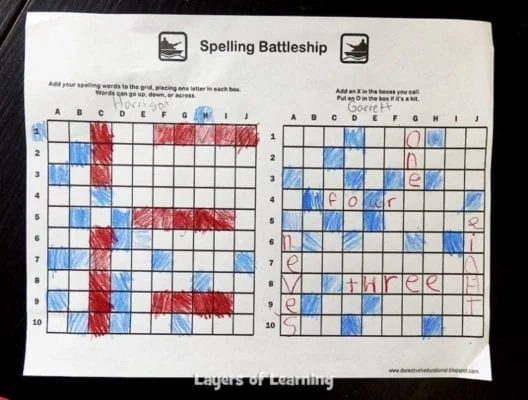
Spelling Tests
Having the kids actually write the words from memory is the only real way to determine if they have learned them adequately. Spelling tests are an excellent learning tool. You can just do a plain Jane spelling test every few days where you say the words and they write them, but you can also make even a spelling test a bit more fun. Here are some ideas.
Write on a Whiteboard
My kids think it’s fun just to write on a whiteboard with colorful markers as a change from the pencil-paper routine.
Write on a Chalkboard
The same goes for a chalkboard. On this day, we did a group spelling test. I wrote the digits up on the board and they took turns coming to board to spell the number words. I let them pick the number word they wanted to spell and their siblings corrected any mistakes. In this way I could see which spellings each child was most comfortable with and maybe what they were avoiding.
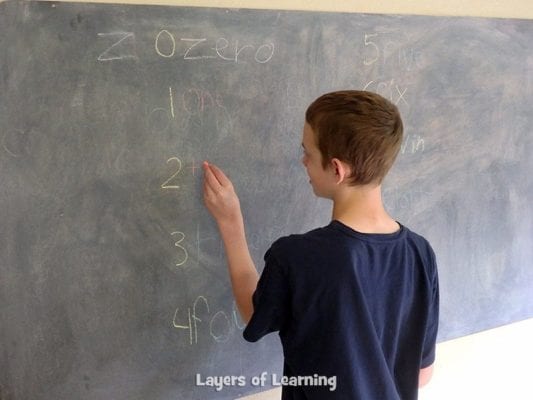
I gave out rewards for spelling attempts, which is another way to add interest and motivation. On this day it was apple slices.

Write Words in a Math Notebook
We are keeping math notebooks through this math basics adventure we’re having. So on one of the spelling practice days we wrote the words in our math notebooks in pencil. They were checked, corrected, and they will be added to with more number words. This will make a reference page that the kids can refer to if they forget. Hopefully though, they will know the words well enough to not need to look them up. that’s kind of the point of all this practice.
Rollin’ Rainbow Spelling
This is something Karen came up with and my kids love. You can learn how to play here. This one is also especially nice for math words because of the numbers and the dice. You could even use a ten sided dice and adjust the game to writing the rolled number as a number word spelled in a color assigned to that number, or something.
Magic Spelling
Another Karen classic. (She’s the fun sister.) In Magic Spelling kids write the spelling word with a white crayon and then paint over it with water color paints to reveal the word. Corrections are made and they try again with the white crayon and more paint. They won’t want to stop practicing.
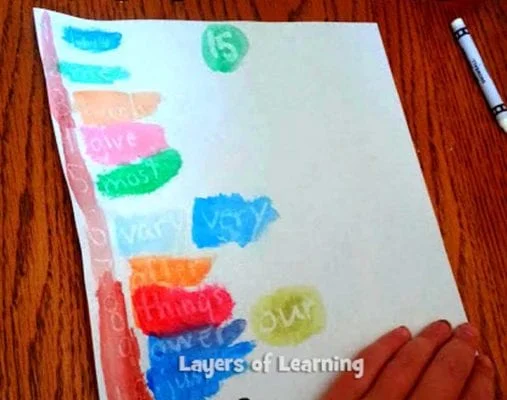
Combine Number Words With Reading Big Numbers and Decimals
If you’re doing this with older kids like I am (from 8th down to 2nd grade) then you might want to jump right in with really big numbers, both reading and writing them, translating from digits to words and back again, and reviewing/re-learning place value. Otherwise you can hold off on this until 3rd and 4th grade.
I wrote the spaces for a number up to the hundred millions place and down to the thousandths place on our big chalkboard (you can also just do it on paper). Then I called each boy up in turn and told him something like “write a 3 in the ten thousands place”. We did this until all of the places were filled. I asked the boys to check and correct each other’s work so they would all pay attention the whole time.
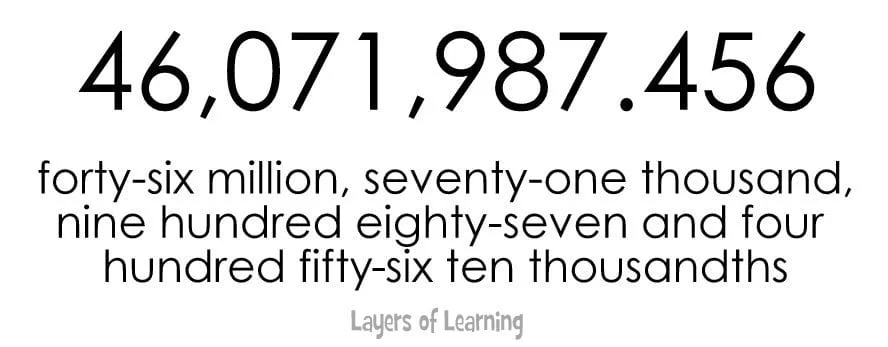
After all the places were filled I asked one of the boys to read the whole number in words. They got it wrong so we went over that you say “million” when you get to the millions comma, and “thousand” when you get to the thousands comma, and “and” when you hit the decimal. The decimal numbers always get them so we practiced that a couple of times. Then we wrote out the entire word in letters beneath the big ol’ number on the board.
This takes lots of practice. Ideally we will do one practice on the board every day. Either I will write a big number and they have to write the words or I will write the words and they have to translate from English into “Math”.
This practice will be essential for learning to translate story problems. First of all, sometimes the numbers are written out in words in story problems, but even more importantly story problems are full of math words that have to be translated into math symbols. This is important practice with that concept, the idea that we can translate from numbers to words and from words to numbers when doing math.
Additional Layers
Make number words real life by finding them in the world around you. They are written on checks, sometimes on signs or ads, in books, and sometimes in the newspaper. In the newspaper you can often find combination words and digits, like 4.2 million. Talk about why it is written that way.
Get a Free Unit
Choose between the first unit in each Layers of Learning subject to try for free when you sign up for the newsletter.
We never spam and you can cancel your subscription at any time.



